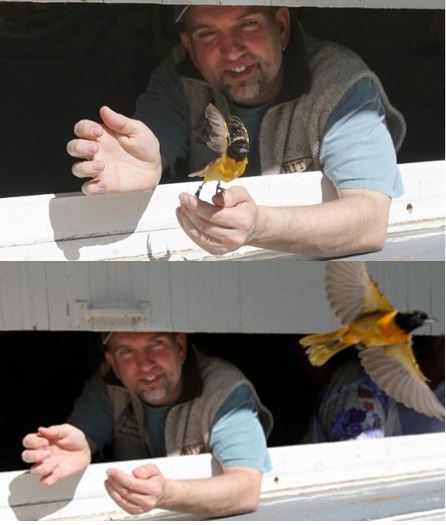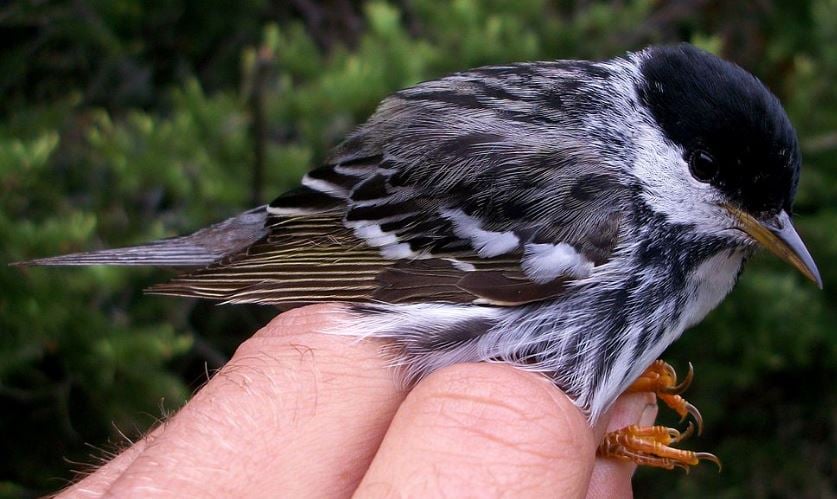Not to mention, the birds that look best behind glasses of water with those extra curves.
Fatter birds get more sex – at the end of their long migration the birds that arrive on the breeding grounds with extra fat stores are likely to experience enhanced reproductive performance, a study found, regardless of sex.
Ornithologists (bird scientists) have long wondered why some birds are fatter than they need to be to fuel their migration.
Jennalee Holzschuh of SUNY College at Brockport, State University of New York, and Mark Deutschlander of Hobart and William Smith Colleges in Geneva, New York, explained in the journal The Auk: Ornithological Advances that their study provided the answer.
 Mark Deutschlander releasing an oriole at the Braddock Bay Bird Observatory, where the study was carried out. (Images: Top – eurekalert.org. Bottom – campus.hws.edu)
Mark Deutschlander releasing an oriole at the Braddock Bay Bird Observatory, where the study was carried out. (Images: Top – eurekalert.org. Bottom – campus.hws.edu)
Surplus fuel from spring migration gives female birds extra energy for reproduction when they reach their breeding grounds.
More fuel at end of the flight means more sex
Birds fatten up before migration to make sure they have enough energy for their long flight. Some of them fatten up a bit more – those are the ones that get more sex, the study found. Not to mention, the birds that look best behind glasses of water with those extra curves.
One hypothesis had proposed that excess fat carried during the spring migration could go towards a bird’s reproductive effort and nesting success, while another suggested it could be insurance against reaching their breeding grounds early when there is not much food about.
Terrestrial ecologist and naturalist Jennalee Holzschuh and Professor of Biology Mark Deutschlander tested these possibilities by gathering and analyzing data from a bird banding station on the south shore of Lake Ontario.
 The Blackpoll Warbler has the longest migration of any species of New World warbler. They have been proven to fly an average of 2,540 kilometres non-stop over an average of 62 hours. (Image: Wikipedia)
The Blackpoll Warbler has the longest migration of any species of New World warbler. They have been proven to fly an average of 2,540 kilometres non-stop over an average of 62 hours. (Image: Wikipedia)
Their findings support the idea that the extra fat aids reproduction – female birds reached their destinations with more fat reserves than males, later birds arrived with more fat than earlier birds, and all the birds were plumper in spring than in autumn.
The researchers analysed 14-years’ worth of data from twelve different warbler species banded at Braddock Bay Bird Observatory. They reported that the patterns were surprisingly consistent across all species.
Banding data a rich source of information
Prof. Deutschlander said:
“I think this paper really illustrates the types of questions and analyses that can be addressed with archived banding data. There are lots of data being collected at bird observatories, and much of it is waiting for interested researchers and students to use that data to address questions about bird migration.”
Ornithologist Frank Moore, from the University of Southern Mississippi, who first outlined the two hypotheses, said:
“Whereas the avian annual cycle may be synchronized to segregate the major energy-demanding functions of molt, migration and reproduction, we recognize that events during any one phase of the annual cycle have repercussions across the entire annual cycle.”
“Holzschuh and Deutschlander study migratory songbirds with a discerning eye toward understanding how energetic condition during passage might carry-over to impact breeding biology. As the authors point out, individuals that arrive on the breeding grounds with surplus fat stores are likely to experience enhanced reproductive performance, regardless of sex.”
Citation: “Do migratory warblers carry excess fuel reserves during migration for insurance or for breeding purposes?” Jennalee Holzschuh and Mark Deutschlander. The Auk: Ornithological Advances. 1 June, 2016. (The hyperlink will be active at the start of office hours at the journal’s offices on 1st June, 2016).
Video – New World Warblers
The New World warblers, also called wood-warblers or North American warblers, are a group of small, generally colourful, passerine birds that make up the family Parulidae and are only found in the New World.
